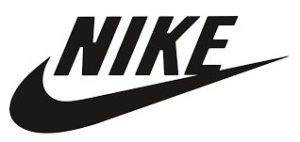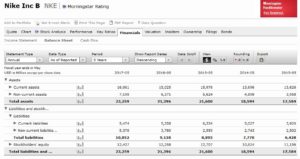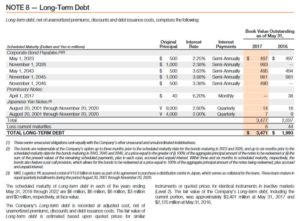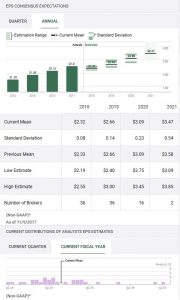Contents
 Summary
Summary
- NKE recently held its Investor Day in which it presented its strategy to improve results.
- Game changing innovation is expected to contribute to improved margins.
- Unlike many other companies, NKE is not using a significant amount of debt to financially engineer its stock price and EPS.
- NKE is suitable for a risk averse investor seeking long-term growth and who is prepared to accept a low dividend yield.
Introduction
Several companies have been raising long-term debt in this low interest rate environment for the purpose of repurchasing shares. The result of this “financial engineering” is that some companies have not actually helped boost the long-term value of the company.
Nike (NYSE: NKE), a component of the FFJ Portfolio, does not fall in this “bucket” of companies. It appeals to me because my wife and I are:
- risk averse (a manageable level of risk is acceptable);
- retired but do not depend on 100% of our rental income and the dividend income generated from our equity investments to sustain our lifestyle;
- seeking long-term investments which can benefit subsequent generations.
Q1 2018 Results and Strategy
Recently, NKE released its Q1 2018 results (September 26, 2017), held its Investor Day (October 25, 2017), and announced (November 16, 2017) an 11% increase in its $0.18/quarter dividend to $0.20/quarter payable January 2, 2018 to shareholders of record at the close of business December 4, 2017.
Results were disappointing but growth is never linear in any industry. Typically, companies will experience periods in which:
- everything is working smoothly and momentum is almost self-sustaining, OR
- circumstances are not ideal thus giving rise to the thought that everything and anything possible must be done to effect change.
NKE’s leadership team has learned that during challenging periods wholesale changes are not necessary. Instead, what need to be done are the right things that matter most. It is by doing the right things that NKE expects to achieve high single-digit revenue growth and mid-teens EPS growth over the next 5 years.
NKE’s goals and objectives will be achieved by addressing evolving consumer demands. Fundamental change will be driven through NKE’s “Triple Double” initiative:
PRODUCT – double cadence and scale of innovation through performance and sports style;
SUPPLY – double speed from product insight to delivery to the consumer;
MARKETPLACE – double direct connections with consumers through digital, membership, and personalization.
NKE has identified “digital” as an early sign of consumer-led disruption in its industry which is providing it with an opportunity to become more deeply connected to consumers. This has led to the development of the “Consumer Direct Offense” in which NKE has realigned itself.
NKE has established key operational measures of success of which the following 5 are the most critical:
- Double the speed and impact of innovation through the introduction of new innovation platforms comprising over 50% of incremental revenue growth over the next 5 years. NKE has already doubled the investment it makes in innovation.
- Grow owned and partnered digital commerce business from less than 15% of revenue in FY2018 to 30%+ over the next 5 years.
NKE envisions digital comprising the vast majority of its business in the market. This will be achieved through growth in the broader application of new digital technologies such as artificial intelligence, voice command, augmented reality and image recognition.
NKE’s digital commerce expansion is also expected to be increasingly driven by NikePlus membership.
- Double the speed to market by reducing the average product creation timelines by 50%. Express Lane initiatives have already resulted in NKE:
- creating products in less than 6 months, from design to delivery to the consumer;
- updating products in less than 3 months, from demand signal to delivery to the consumer;
- fulfilling or replenishing sold-out product in a matter of days.
- NKE has set a 65% target of full price sell-through in season with 25% surgical markdowns in season. The intent is to have less than 10% of products needing to be sold out of season. The impact will be that each percentage point of improvement in full price sell-through over a year could deliver as much as $0.1B in margin benefit.
- NKE will continue to closely track consumer’s perception of its brand and their engagement with the NKE brand in each of the 12 key cities and 10 key countries it has identified as fueling over 80% of its projected revenue growth.
Projections for 4 Regions
Page 5 of 6 of NKE’s Q1 results in its September 25, 2017 Press Release reflects revenue for NKE’s 4 regions: North America (NA), Greater China (GC), Europe, Middle East & Africa (EMEA), and Asia Pacific and Latin America (APLA); international markets represent ~55% of NKE’s business and this percentage is projected to grow.
NA
NKE’s North American business generates ~ $15B in revenue and growth is expected to be in the mid single digit range over the next 5 years; NKE’s projected NA growth rate takes into account the risk of further retail disruption than that experienced to date.
Over 60% of its business in this region is generated through conventional distribution channels but NKE expects this to contract over the next 5 years. Digital and physical channels, owned and partnered, will expand to over 80% of its business.
GC
Low to mid-teens revenue growth is forecast given that sport participation and the culture of sport are expanding.
NKE has indicated that distribution in China has leapfrogged many of the stages of physical and digital retail development in NA. As a result, it is very bullish about its growth opportunities in this region.
EMEA
Mid to high single digit revenue growth over the next 5 years is projected with NKE currently being the #1 favorite brand in all 5 key cities (London, Paris, Berlin, Barcelona, and Milan) across this region.
Aggressive roll-out of Nike.com and mobile apps is underway to serve the very strong demand for the NIKE brand. In addition, NKE is investing heavily in enhanced local digital capabilities.
APLA
High single digit to low double digit revenue growth is projected over the next 5 years with growth benefiting from an emerging middle class and the passion for sport (most notably football/soccer).
Three (Tokyo, Mexico City, and Seoul) of NKE’s 12 key cities will drive extraordinary growth. NKE is currently the #1 favorite brand with the over 85 million consumers in just these 3 cities!
While opportunities lie in football/soccer and sportswear, NKE also sees tremendous growth opportunities in women, running, basketball and “Jordan”.
4 Key Drivers for Margin Expansion
NKE has identified 4 key drivers for margin expansion.
- NKE’s “Direct” businesses are growing at a much faster rate than third-party wholesale and margins in these businesses are significantly higher than in its third-party wholesale business.
- NKE sees an opportunity to continually enhance the price-value relationship for the consumer by doubling the impact of innovation within its product mix. Through the modification of the assortment of products NKE will be able to place greater focus on the products consumers love the most.
- Continuous product innovation that improves performance while also significantly reducing the cost of materials through the reduction of waste. NKE is increasing its level of automation to improve speed of production and to reduce its reliance on labor by expanding its capabilities with existing strategic partners and by bringing new manufacturers into the industry (eg. Flex and Tegra).
Through NKE’s strategic relationship with Flex, for example, game-changing innovations are being brought to market and are being scaled faster than ever before.
Together with Flex, NKE is now producing footwear using “NIKE Flyleather”. This new recycled leather has at least 50% leather fiber made on a roll versus leather coming from a hide. It is 40% lighter and 5 times more abrasion-resistant than traditional full grain leather manufacturing. Because “NIKE Flyleather” is produced as a traditional rolled good instead of an imperfect hide, NKE is now able to produce shoes much faster and with greater flexibility and is benefiting from a reduction in material costs.
Flex will deliver over 3 million pairs of shoes to NA in FY2018. Together with Flex, NKE plans to produce tens of millions of pairs of shoes by 2023 with more than 25% of this volume delivered through NIKE Direct on a short lead time responsive model.
This strategic relationship with Flex is enabling NKE to reduce its standard manufacturing to market timeframe from ~60 days to 10 days or less.
- By doubling the combination of Speed and “Direct”, NKE will be closer to consumers which will improve demand and supply management and will result in more consistent full price sell-through.
Investment for Growth and Profitability
Selling, General, and Administration expenses are expected to expand in areas that will differentiate NKE as the long-term leader.
NKE expects to reinvest about 3% to 4% of its revenue in capital expenditures over the next 5 years with heavy focus on product innovation, product creation, brand marketing, and the digital technologies and talent required to enable more personal service on a large scale level.
Although NKE will invest in building in-house capabilities it will also be increasing its investment in the acquisition of capabilities, or co-investing with partners, to accelerate its strategies. NKE will also continue to pursue opportunities to invest through acquisition or to partner in areas such as data science and analytics, machine learning, augmented reality, artificial intelligence, and digital product creation.
In November 2015, NKE’s Board of Directors approved a 4 year $12B share repurchase program. In Q1 2018 NKE repurchased 15.3 million shares for ~$0.849B thus bringing the total number of shares repurchased under the program to 95.0 million for a total of ~$5.3B.
These repurchases have contributed in part to NKE’s long-term debt slightly more than doubling in 5 years. Unlike other companies, however, which have taken on significant long-term debt on their balance sheet for the purpose of repurchasing shares, NKE has an extremely strong balance sheet. As at August 31, 2017, Total Current Assets (~$16B) exceeded TOTAL Liabilities (~$11.65B).
 Source: Morningstar
Source: Morningstar
The following schedule of Long-Term Debt is not nearly as daunting as other schedules I have reviewed.
 Source: NKE FY2017 Form 10-K
Source: NKE FY2017 Form 10-K
I recognize the capital structure of a company is heavily dependent on multiple factors, and therefore, the use of leverage may be totally appropriate in one industry but not another. Lately, however, some companies have been taking advantage of the low interest rate environment to raise a significant amount of leverage for the purpose of repurchasing outstanding shares.
This has, in some cases, resulted in share price and EPS increases well beyond historical norm. While this might be an entirely appropriate strategy for some companies I question what will happen to the rate of growth in these two metrics once a company reaches the stage where it no longer makes sense, or it is no longer possible, to raise debt to retire outstanding shares.
As investors we may have a different tolerance for risk and different goals and objectives. As a result, some investors may be entirely in favor of the use of leverage to retire shares. My investor profile, however, is as laid out in the Introduction of this article.
One reason NKE appeals to me is because of its conservative use of debt. With a fairly clean balance sheet (note how Goodwill and Identifiable Intangible Assets are also negligible!) NKE has the flexibility to do what it needs to do to grow its business in an environment where consumer tastes and purchase habits are subject to radical change.
Dividend, Dividend Yield, and Dividend Payout Ratio
Regrettably, NKE’s website only has easily accessible dividend information dating back to FY2007. I have, therefore, obtained dividend information prior to this period directly from NKE’s Annual Reports.
While NKE has rewarded investors with double digit percentage dividend increases for the past several years, it did hold its dividend constant in FY1999 – 2002.
The dividend payout ratio target range is currently 25-35%; this range was communicated October 2015.
NKE’s dividend yield following its November 16, 2017 announcement of a $0.20/quarter dividend is 1.35% (using the $59.19 November 16, 2017 closing price). This results in a dividend yield that is in line with historical levels.
Given NKE’s target dividend payout range and the recently announced quarterly dividend, NKE’s new annual dividend payout ratio (~34.4) is near the upper end of the dividend payout ratio target range ($0.80/$2.32).
Valuation
$2.32 is the current mean projected adjusted EPS from 36 brokers. This translates into a ~25.5 PE based on the current $59.19 November 17, 2017 closing stock price. This is relatively consistent with recent historical levels.
Nike Stock Analysis – Final Thoughts
I view NKE’s recent headwinds as temporary. I am confident management knows what needs to be done and how to execute its plan to adapt to the rapidly changing retail environment. The changes presented during NKE’s recent Investor Day presentation suggest to me that NKE will be a stronger company 5 years from today.
My intent is to retain our NKE shares in the FFJ Portfolio, reinvest all dividends, and to make periodic additional purchases as funds permit.
I wish you much success on your journey to financial freedom.
Thanks for reading!
Note: I sincerely appreciate the time you took to read this post. As always, please leave any feedback and questions you may have in the “Contact Me Here” section to the right.
Disclaimer: I have no knowledge of your individual circumstances and am not providing individualized advice or recommendations. I encourage you not to make any investment decision without conducting your own research and due diligence. You should also consult your financial advisor about your specific situation.
Disclosure: I am long NKE.
I wrote this article myself and it expresses my own opinions. I am not receiving compensation for it and have no business relationship with any company whose stock is mentioned in this article.



